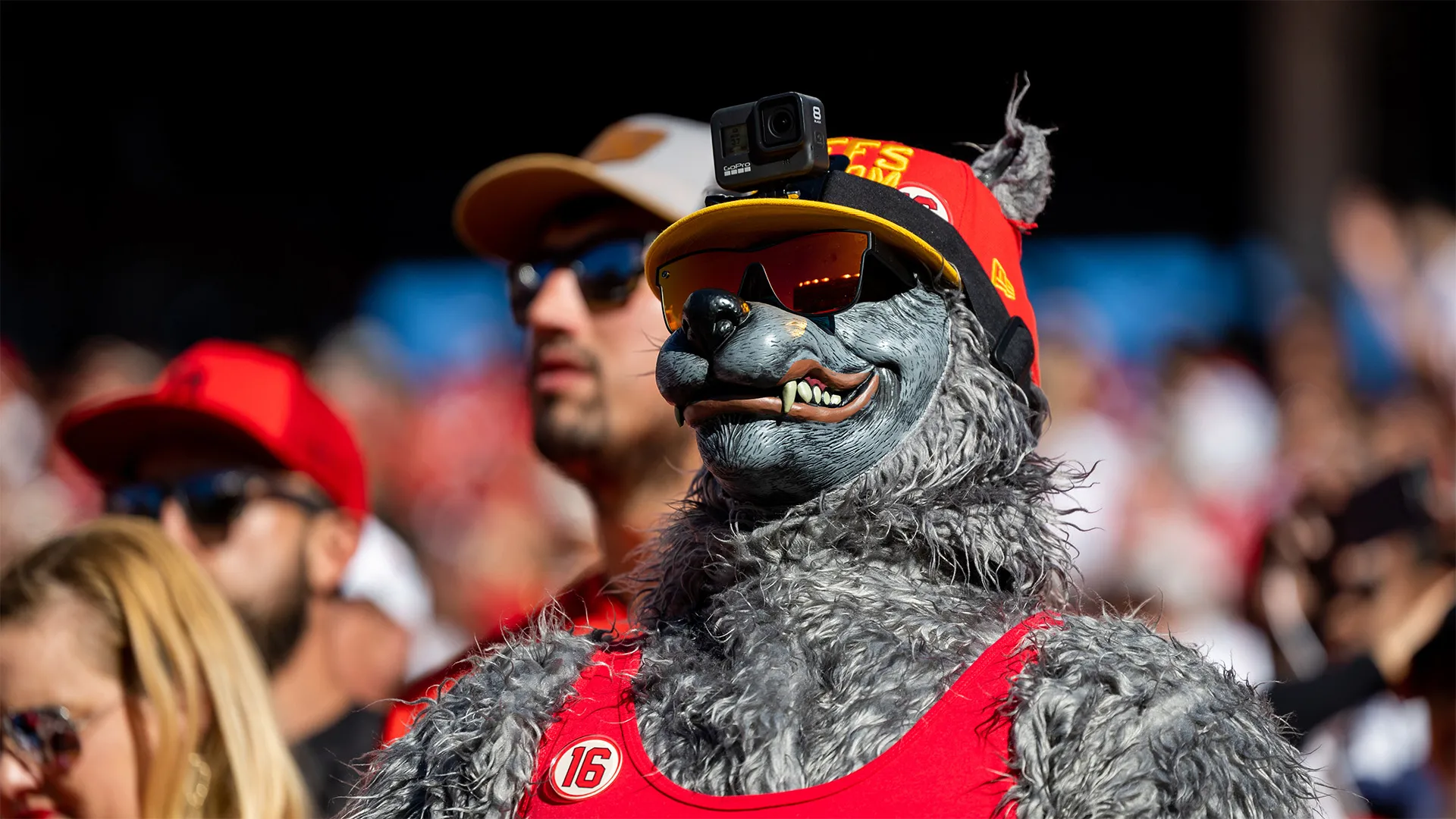The documentary centers on Xaviar Babudar, a figure emerging from the ranks of passionate Kansas City Chiefs supporters while leading a concealed life of criminal enterprise.
Babudar’s profile is marked by a stark contradiction: a fervent admirer of the sport whose enthusiasm shadows meticulously orchestrated bank robberies.
The narrative charts his evolution from an ardent superfan into an individual entangled in risky, unlawful pursuits, prompting a serious examination of how intense devotion can coexist with covert misconduct.
Positioned amid an environment charged with the energy of live sports and amplified by the reach of digital networks, the film draws on vivid depictions of both the roar of the stadium and the tension inherent in high-stakes heists. Authentic interviews, archival recordings, and re-enactments combine to present a textured account of events.
Real-life scenes—from packed game-day arenas to the stealth of criminal operations—form a setting that highlights the stark reality underlying Babudar’s public image. A final set of striking visuals and measured testimonies reinforces the film’s intricate narrative structure.
Contrasting Figures: The Dual Persona and Its Echoes
Xaviar Babudar emerges as a figure marked by stark disjunction. Raised amid hardship and familial discord, his early life hints at a future marred by unpredictable choices.
His progression from a typical sports enthusiast into a notorious character is charted with meticulous care. Babudar’s actions reveal a convergence of desperate familial duty and an overpowering impulse linked to his gambling practices.
His fervor for the game, once a source of pure adulation, transforms into an instrument for sustaining a lifestyle steeped in criminal behavior. This transformation exposes a character oscillating between the genuine devotion to a team and the calculated risks inherent in illegal pursuits, each facet reinforcing the other in an almost inescapable loop.
Michael Lloyd, the bail bondsman, occupies a contrasting yet essential role. His presence casts light on the moral complexities of the situation, where financial involvement intersects with ethical dilemmas.
Lloyd’s commitment, framed by the precarious nature of his business and the unpredictable outcomes of his client’s actions, invites a closer examination of accountability in a system strained by human frailty.
Other voices—from bank employees who endured direct threats to law enforcement figures recounting high-tension encounters—contribute critical layers to the narrative.
Each perspective, whether from the frontline of crime or from the fervor of dedicated sports supporters, constructs a multifaceted image of Babudar.
The collective commentary from these sources shapes an understanding that transcends a simplistic view of a criminal mastermind or an overly zealous fan.
Instead, it suggests a personality forged at the intersection of societal pressures and personal compulsion, where public admiration coexists with a capacity for self-destruction, creating an enduring enigma that challenges established notions of heroism and villainy.
Chronicles in Motion and Visual Rigor
From the onset, the film traces the rise of Babudar, whose social media prominence emerges alongside his covert undertakings.
The progression is methodically charted, beginning with a spirited depiction of a diehard fan immersed in the fervor of Kansas City football.
As the plot unfolds, key milestones mark the turning points in his clandestine journey: a moment of startling revelation when evidence of his illicit endeavors comes to light, sequences capturing daring bank heists, and a dramatic shift as a widespread pursuit ensues.
Each segment of the timeline contributes to a mounting sense of anticipation that steadily grips the viewer.
Interwoven with the chronological narrative is a skilled use of visual storytelling that combines candid interviews with meticulously recreated sequences.
The film interposes first-hand testimonies from individuals drawn into the unfolding drama, archival imagery of electrified game days, and stark footage of police confrontations.
These components merge to form a framework where raw accounts and staged representations exist in balanced accord. The seamless integration of live narratives and re-enacted moments furnishes the viewer with a continuous, immersive experience.
A series of real-life recordings—unvarnished and intense—imbues the sequence with an urgent tone that sharpens the portrayal of Babudar’s duplicity.
The pacing is measured with a deliberate cadence, inviting viewers to absorb the impact of each twist gradually.
The shifting rhythm—from the initial display of zealous admiration to the climactic unmasking of illicit deeds—carries a refined structure that remains both methodical and absorbing.
Through its strategic assembly of interviews, live recordings, and reenactments, the film presents an arresting portrayal of events that unfolds with inexorable precision. The construction of this narrative, marked by a careful layering of fact and dramatization, stands as a striking exploration of a life played out on the razor’s edge.
Intersections of Fandom, Poverty, and Ethical Quandaries
The film examines the contemporary fixation on sports culture and the allure of public personae, probing the delicate line that separates fervent devotion from disordered behavior.
Babudar’s evolution from an enthusiastic supporter to a figure entangled in illicit actions compels a reassessment of the cultural forces shaping identity.
His active presence on social media functions as a mirror reflecting society’s hunger for spectacle and rapid recognition, suggesting that extreme fan behavior may stem from deep-seated pressures and a desire for validation.
Set against an environment marked by economic struggle, the narrative scrutinizes how early experiences of instability and material scarcity can drive individuals toward radical choices.
Babudar’s troubled upbringing, shadowed by familial discord and financial deprivation, serves as a stark reminder of the influence that hardship can exert on personal decisions.
His engagement in risky ventures—symbolized by spontaneous gambling and bold bank heists—illustrates a search for meaning amid personal chaos and the constant pull of an unforgiving world.
The portrayal of Michael Lloyd, the bail bondsman, introduces a further layer of ethical complexity.
His situation, defined by the interplay of financial risk and moral conflict, casts a critical light on a system where commercial interests may overshadow ethical considerations. Contributions from law enforcement officers and bank personnel offer voices that question a framework where individual accountability merges with institutional shortcomings.
The film employs a combination of candid interviews, reconstructed sequences, and authentic recordings to capture these dynamics with deliberate pacing and visual acuity, crafting a narrative that interrogates established assumptions about responsibility and social order while prompting reflection on the intricate ties between personal ambition, desperation, and the cost of notoriety.
Cinematic Craft: A Symphony of Technique and Vision
Director Dylan Sires crafts a narrative where the interplay of light, sound, and motion shapes a refined yet arresting portrait of its subject. His approach to storytelling privileges a steady fusion of kinetic energy and deliberate restraint.
The film oscillates between moments of dynamic spectacle and measured stillness, guiding the viewer through shifting atmospheres that mirror the unpredictable rhythm of its unfolding events.
Sires orchestrates a balance between the shock of sudden revelations and the subdued cadence of character study, his direction marked by a steadfast focus on visual clarity.
The visual composition relies on authentic on-site recordings that capture the immediacy of bustling stadiums and the subdued tension of clandestine activities. Camera work reveals a proficiency in seizing both the grandeur of live events and the intimacy of carefully staged reenactments.
Police footage, crisp recordings of emergency calls, and snapshots of digital chatter converge seamlessly with meticulously chosen angles.
The editing process preserves a deliberate tempo, enabling each segment to breathe and resonate while steadily amplifying the film’s inherent suspense.
Sound design is meticulously calibrated to reinforce the unfolding drama. The background score, interlaced with precise sound effects, punctuates critical junctures with a measured intensity that heightens the emotional resonance of each scene.
Audio cues, extracted from the ambient clamor of game-day gatherings and the urgent tones of emergency communications, integrate seamlessly with the visual narrative, producing an immersive sensory experience. Every carefully orchestrated auditory element contributes to an overall rhythm that mirrors the pulse of the unfolding drama.
Through these techniques, Sires transforms conventional narrative tools into instruments of profound expression, crafting a film that challenges established storytelling norms while engaging both the eye and the ear in a continuous, artful dialogue.
The Emotional Imprint: Contours of Response
The film’s narrative arc provokes a spectrum of feelings that traverse the realms of empathy, shock, and intrigue.
Scenes unfurl in rapid succession, each crafted to unsettle and captivate—moments when the fervor of unabashed fandom collides with the stark reality of calculated transgressions.
A visceral tension emerges from this collision, as the audience is drawn into a state where admiration for unabated passion intermingles with a deep-seated disquiet at the unfolding criminality.
One finds oneself silently compelled by the audacity of a character whose public exuberance masks a life veering sharply into lawlessness.
Underneath this charged visual and narrative tapestry, the film raises potent ethical inquiries concerning identity, redemption, and the profound costs borne of obsession.
It casts a discerning light on the allure of renown and the dangerous pathways it may forge—a societal critique that questions the frameworks of fame, the nature of culpability, and the price of relentless ambition. The juxtaposition of celebrated fandom with the undeniable consequences of reckless actions leaves an indelible impression.
Viewers are not only entertained but are also invited to ponder broader cultural questions regarding responsibility and the moral equilibrium of modern society.
Each sequence is calibrated to provoke dialogue, inviting the audience to reassess entrenched societal norms while remaining suspended in a dialogue that challenges the status quo without yielding to facile resolutions.
The Review
ChiefsAholic: A Wolf in Chiefs Clothing
The documentary interrogates the extremes of sports fandom and personal downfall with unyielding visual and narrative precision. Its multi-faceted portrayal of a man split between public adoration and hidden transgression invites reflection on societal fixations and the cost of radical choices. By weaving rigorous ethical inquiry with arresting imagery and unrelenting tension, the film challenges conventional narratives and ignites thoughtful discourse on modern cultural dynamics.
PROS
- Unconventional narrative that fuses sports culture with true crime.
- Visually striking with dynamic reenactments and authentic footage.
- Provocative exploration of ethical dilemmas and modern fandom.
- Strong character development with layered, complex portrayals.
CONS
- Some reenactments may appear overly dramatic.
- Occasional uneven pacing in parts of the narrative.




















































